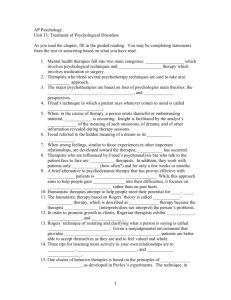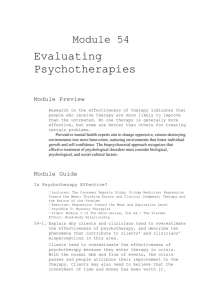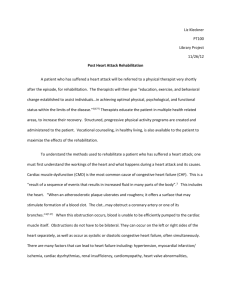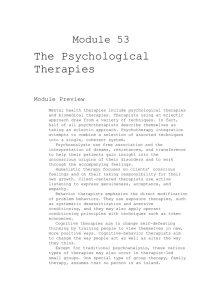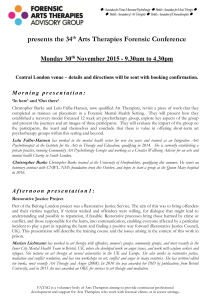click to read more
advertisement
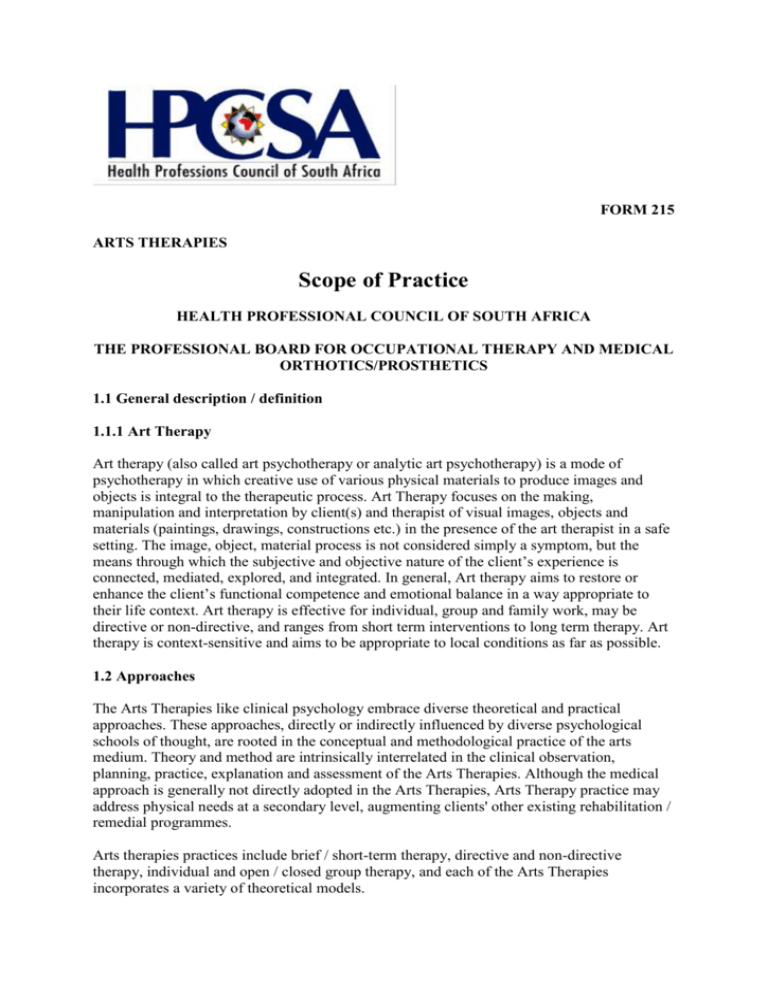
FORM 215 ARTS THERAPIES Scope of Practice HEALTH PROFESSIONAL COUNCIL OF SOUTH AFRICA THE PROFESSIONAL BOARD FOR OCCUPATIONAL THERAPY AND MEDICAL ORTHOTICS/PROSTHETICS 1.1 General description / definition 1.1.1 Art Therapy Art therapy (also called art psychotherapy or analytic art psychotherapy) is a mode of psychotherapy in which creative use of various physical materials to produce images and objects is integral to the therapeutic process. Art Therapy focuses on the making, manipulation and interpretation by client(s) and therapist of visual images, objects and materials (paintings, drawings, constructions etc.) in the presence of the art therapist in a safe setting. The image, object, material process is not considered simply a symptom, but the means through which the subjective and objective nature of the client’s experience is connected, mediated, explored, and integrated. In general, Art therapy aims to restore or enhance the client’s functional competence and emotional balance in a way appropriate to their life context. Art therapy is effective for individual, group and family work, may be directive or non-directive, and ranges from short term interventions to long term therapy. Art therapy is context-sensitive and aims to be appropriate to local conditions as far as possible. 1.2 Approaches The Arts Therapies like clinical psychology embrace diverse theoretical and practical approaches. These approaches, directly or indirectly influenced by diverse psychological schools of thought, are rooted in the conceptual and methodological practice of the arts medium. Theory and method are intrinsically interrelated in the clinical observation, planning, practice, explanation and assessment of the Arts Therapies. Although the medical approach is generally not directly adopted in the Arts Therapies, Arts Therapy practice may address physical needs at a secondary level, augmenting clients' other existing rehabilitation / remedial programmes. Arts therapies practices include brief / short-term therapy, directive and non-directive therapy, individual and open / closed group therapy, and each of the Arts Therapies incorporates a variety of theoretical models. 1.2.1 Art Therapy Analytical Art Therapy Art Psychotherapy Psychodynamic Art Therapy Activity-based Art Therapy 1.3 Client populations / groups Clients are usually referred to an Arts therapist by recognised health-care workers. These include medical doctors, psychiatrists, clinical psychologists, social workers, occupational therapists, speech therapists, physiotherapists, mental health counsellors, and teachers. Because the Arts therapies primarily offer opportunities for non-verbal therapeutic work, the disciplines are well-suited to addressing a range of acute and chronic illnesses/disabilities/disorders. The Arts therapies may be used with the following populations: a) Developmental delay b) Physical disability c) Mental disability d) Emotional disturbance e) Persons suffering from psychiatric illness (adults, adolescents and children, in- and outpatients; individual and groups) f) Learning disabilities g) Autism h) Sensory impairments i) Geriatric conditions j) Language/communication disorders (including hearing impairments) k) Neurological injuries/traumas l) Persons in life transitions m) The elderly n) Persons undergoing rehabilitation from substance abuse o) Persons suffering from pain and anxiety within medical settings p) People suffering from stress, trauma, bereavement and other life crises q) People seeking personal growth and self-development. r) Groups seeking conflict resolution and team building. s) Family Service Agencies and community settings t) Victims of violence and sexual abuse u) Members of the so-called ‘normal neurotic’ population v) Offenders and prison populations w) Persons suffering from terminal illnesses 1.4 Expected outcomes of the Arts Therapies a) Improved awareness of self (integration of physical, emotional, intellectual and social). b) Improved awareness of physical environment c) Improved awareness of significant others, peers, and groups d) Improved attention to self, others and physical environment e) Improved perception and discrimination in sensori-motor areas f) Improved insight about self, others and the environment g) Improved self-expression, containment of emotions and impulse control h) Improved interpersonal communication i) Improved integration of self (sensory-motor experiences, levels of consciousness, parts of self, time, roles, etc.) j) Improved interpersonal relationships with significant others, peers, and groups k) Improved self-confidence/assertiveness l) Developing self-control with regard to destructive and aggressive impulses m) Improved cognitive skills n) Improved motor skills, o) Pain and anxiety management In addition to 1.4: 1.4 (i) Art Therapy a) Enhanced general creativity in the use of art materials and more broadly 1.5 Contexts where Arts Therapies may be applied: 1.5.1 Educational The Arts Therapist is part of the teaching / remedial team and is administratively accountable to the Head Teacher, or to the person responsible for educational programme. The Arts Therapist’s remit includes accepting referrals from appropriate professionals, assessing children, designing and implementing treatment programmes, writing and submitting regular reports, and attending case conferences. The Arts Therapists may work in: a) Mainstream schools, pre-primary, primary and secondary b) Special Schools, pre-primary, primary and secondary, e.g. schools for physically disabled children, schools for mentally handicapped children, schools for children with learning difficulties, schools for autistic children, schools for emotionally disturbed children, schools for children with hearing problems and schools for blind children. c) Other educational contexts e.g. long-term hospitalisation educational programs. d) Trade and business educational programs e) Adult education programmes 1.5.2 Health Team The Arts Therapies covers psychotherapeutic and rehabilitative work, and the Arts Therapists are part of the multi-disciplinary team, and administratively accountable to the Head Physician / Head of the Unit or some senior person designated by the host institution. The Arts Therapist’s remit includes accepting referrals from the multi-disciplinary team and from individual professionals within the unit, assessing new patients, designing and implementing treatment programme, writing and submitting regular reports, attending case conferences. The Arts Therapists work in private and public sector: a) paediatric clinics b) primary health care clinics c) general hospitals d) psychiatric hospitals / clinics e) clinics for communication disorders f) geriatric care units g) chronic mental health care units h) chronic physical health care units i) chronic neurological health care units j) ante-natal and post-natal clinics k) hospices 1.5.3 Rehabilitation The Arts Therapist is part of the multi-disciplinary health / rehabilitation team, accepts referrals from the multi -disciplinary team and from individual professionals within the unit, assessing new patients, designing and implementing appropriate Arts Therapies treatment programmes, writing and submitting regular reports, attending case conferences. The Arts Therapists work with clients who are in rehabilitation from : a) physical injuries b) neurological injuries c) mental illness d) emotional trauma e) drug and/or alcohol dependency 1.5.4 Correctional services The Arts Therapist is part of the psychological support offered to long -term and short-term prisoners, provides individual and groups sessions, and is part of the rehabilitation process of prisoners prior to being released. 1.5.5 Community work This includes recreational, enrichment and developmental aspects of the Creative Arts. The Arts Therapists work with clients who are in community development / promotive / preventative / support programs such as: a) early Childhood Development programs b) youth development programs c) educational programs for out- of- school children and homeless children d) primary health care clinics e) family counselling f) community day centres g) community day centres for the elderly 1.5.6 Long-term Care for Person with Mental Disabilities The Arts Therapists are part of the multi-disciplinary team within the residential / day-care setting providing long-term as well as short-term programmes. 1.5.7 Private Practice The Arts Therapists who have fulfilled the requirements for registration with the HPCSA. and who have received at least three years’ cumulative supervision from a registered Arts Therapist or from a registered mental health professional, one year of which is during post qualification working experience in a professional context may practice in their private capacity. This is an excerpt from the HPCSA Scope of Practice of Arts Therapies Document, which is a 34-page document that includes standards of training and guidelines for registration. For the full document, please contact me with a request.


